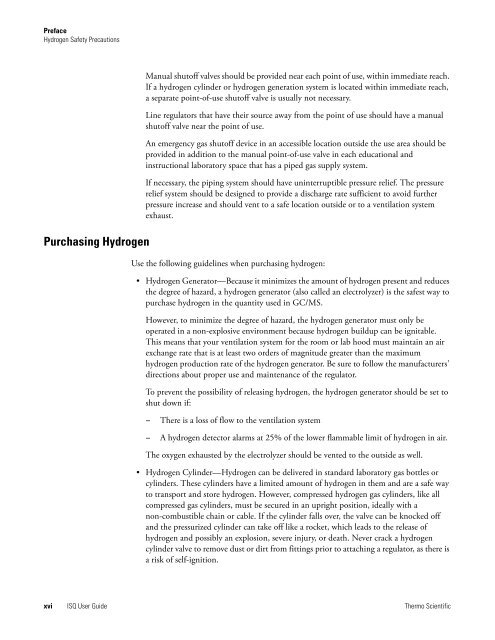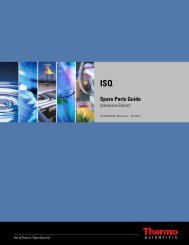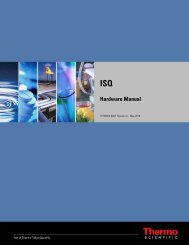ISQ User Guide - Write Frame of Mind
ISQ User Guide - Write Frame of Mind
ISQ User Guide - Write Frame of Mind
Create successful ePaper yourself
Turn your PDF publications into a flip-book with our unique Google optimized e-Paper software.
Preface<br />
Hydrogen Safety Precautions<br />
Purchasing Hydrogen<br />
Manual shut<strong>of</strong>f valves should be provided near each point <strong>of</strong> use, within immediate reach.<br />
If a hydrogen cylinder or hydrogen generation system is located within immediate reach,<br />
a separate point-<strong>of</strong>-use shut<strong>of</strong>f valve is usually not necessary.<br />
Line regulators that have their source away from the point <strong>of</strong> use should have a manual<br />
shut<strong>of</strong>f valve near the point <strong>of</strong> use.<br />
An emergency gas shut<strong>of</strong>f device in an accessible location outside the use area should be<br />
provided in addition to the manual point-<strong>of</strong>-use valve in each educational and<br />
instructional laboratory space that has a piped gas supply system.<br />
If necessary, the piping system should have uninterruptible pressure relief. The pressure<br />
relief system should be designed to provide a discharge rate sufficient to avoid further<br />
pressure increase and should vent to a safe location outside or to a ventilation system<br />
exhaust.<br />
Use the following guidelines when purchasing hydrogen:<br />
• Hydrogen Generator—Because it minimizes the amount <strong>of</strong> hydrogen present and reduces<br />
the degree <strong>of</strong> hazard, a hydrogen generator (also called an electrolyzer) is the safest way to<br />
purchase hydrogen in the quantity used in GC/MS.<br />
However, to minimize the degree <strong>of</strong> hazard, the hydrogen generator must only be<br />
operated in a non-explosive environment because hydrogen buildup can be ignitable.<br />
This means that your ventilation system for the room or lab hood must maintain an air<br />
exchange rate that is at least two orders <strong>of</strong> magnitude greater than the maximum<br />
hydrogen production rate <strong>of</strong> the hydrogen generator. Be sure to follow the manufacturers'<br />
directions about proper use and maintenance <strong>of</strong> the regulator.<br />
To prevent the possibility <strong>of</strong> releasing hydrogen, the hydrogen generator should be set to<br />
shut down if:<br />
− There is a loss <strong>of</strong> flow to the ventilation system<br />
− A hydrogen detector alarms at 25% <strong>of</strong> the lower flammable limit <strong>of</strong> hydrogen in air.<br />
The oxygen exhausted by the electrolyzer should be vented to the outside as well.<br />
• Hydrogen Cylinder—Hydrogen can be delivered in standard laboratory gas bottles or<br />
cylinders. These cylinders have a limited amount <strong>of</strong> hydrogen in them and are a safe way<br />
to transport and store hydrogen. However, compressed hydrogen gas cylinders, like all<br />
compressed gas cylinders, must be secured in an upright position, ideally with a<br />
non-combustible chain or cable. If the cylinder falls over, the valve can be knocked <strong>of</strong>f<br />
and the pressurized cylinder can take <strong>of</strong>f like a rocket, which leads to the release <strong>of</strong><br />
hydrogen and possibly an explosion, severe injury, or death. Never crack a hydrogen<br />
cylinder valve to remove dust or dirt from fittings prior to attaching a regulator, as there is<br />
a risk <strong>of</strong> self-ignition.<br />
xvi <strong>ISQ</strong> <strong>User</strong> <strong>Guide</strong> Thermo Scientific






